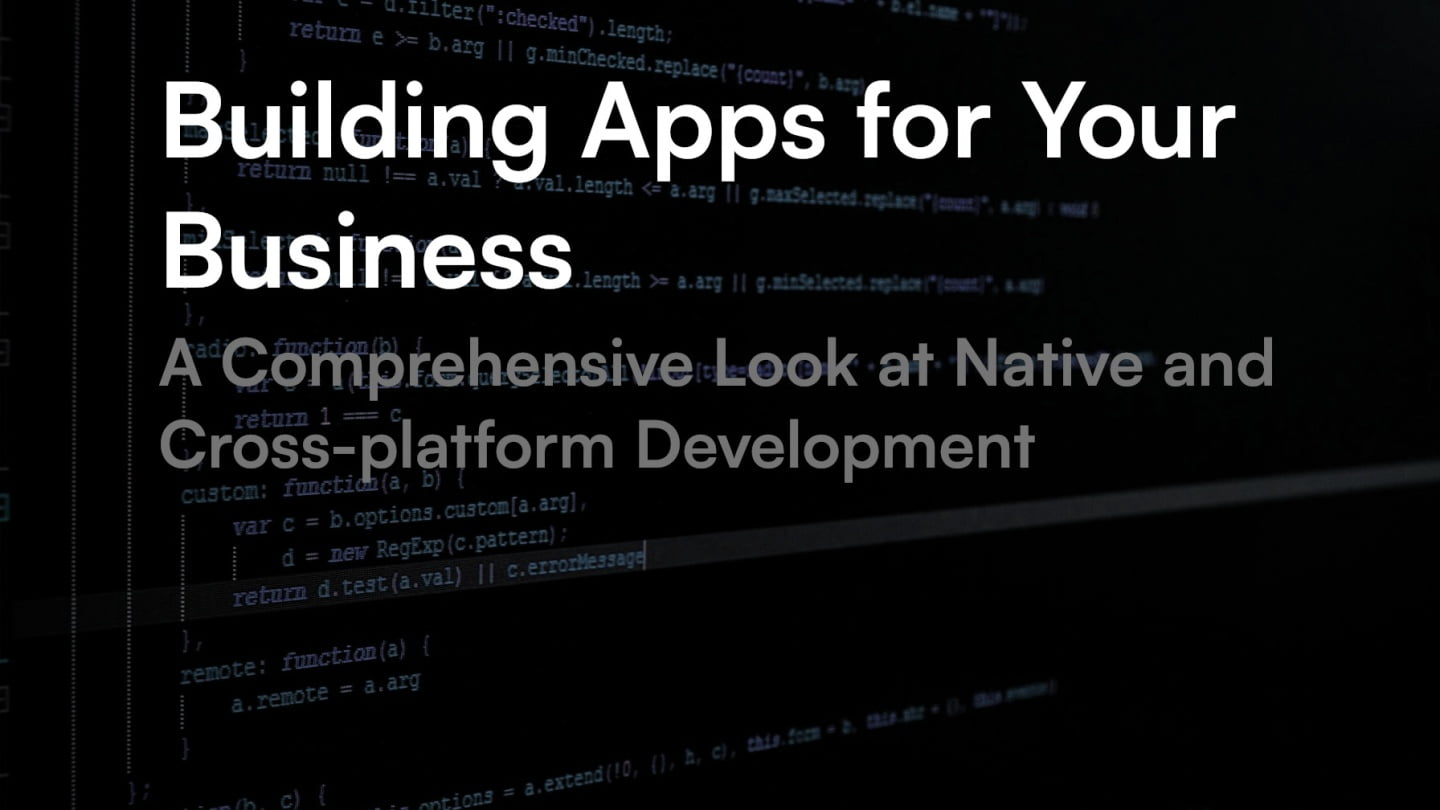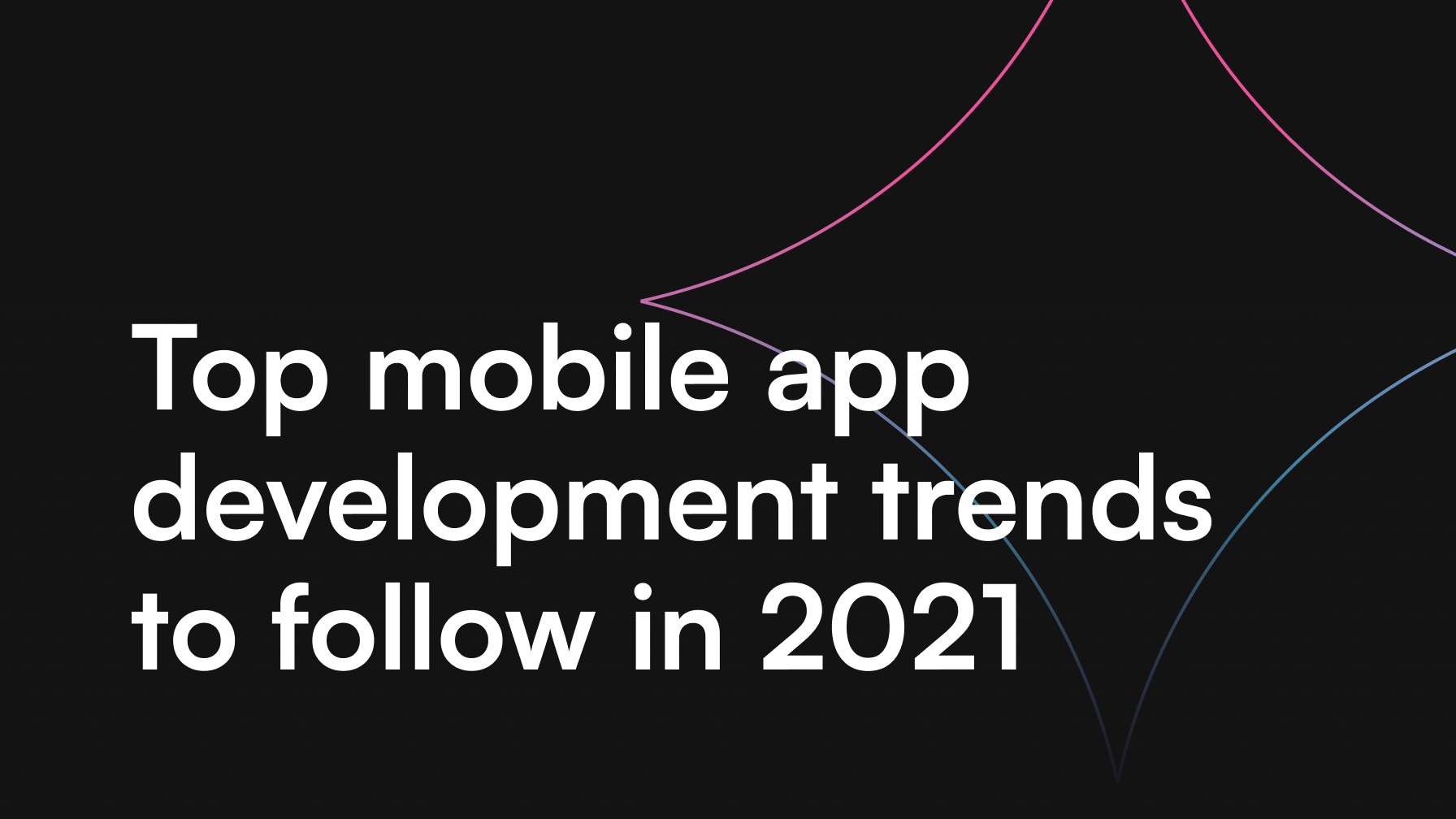Building Apps for Your Business: A Comprehensive Look at Native and Cross-platform Development

Krzysztof Hubnicki

In a world where smartphones rule the roost, businesses are continuously striving to keep pace with technological innovation. Mobile applications have become a cornerstone for engaging customers and streamlining operations, but the path to successful app development is riddled with choices. Among the crucial decisions lies the choice between native and cross-platform development. Each approach has its proponents, but as the digital ecosystem evolves, cross-platform solutions are emerging as a powerful alternative. This article explores the burgeoning landscape of mobile app development, with an emphasis on cross-platform strategies, laying out all you need to know as an entrepreneur. Whether you’re new to the world of apps or looking to sharpen your existing strategy, the insights presented here will guide you towards making informed, future-proof decisions.
Introduction
a. The Need for Mobile Apps in Business
b. App Market Development
c. Purpose and Scope of the Article
Understanding the Basics
a. What Are Native and Cross-platform Development?
b. Comparison and Contrast
c. Technology Selection: When to Use What?
Native Development
a. Definition and Features
b. Pros and Cons
c. Examples and Tools
Cross-platform Development
a. Definition and Features
b. Pros and Cons
c. Examples and Tools
Choosing the Right Approach for Your Business
a. Requirement Analysis
b. Resource and Budget Assessment
c. Long-term Strategy and Support
App Creation Process
a. Planning and Designing
b. Building and Testing
c. Deployment and Support
Use Cases and Case Studies
a. Success Examples of Native Development
b. Success Examples of Cross-platform Development
Legal and Ethical Considerations
a. Privacy and Security
b. Regulatory Compliance
Future and Trends
a. Latest Technologies and Innovations
b. What the Future Holds?
Conclusion
a. Key Takeaways
b. Recommendations for Entrepreneurs
References and Sources
Introduction
a. The Need for Mobile Apps in Business
In today’s digital landscape, mobility has become an integral part of daily life. Businesses across various industries are recognizing the growing value in developing mobile apps. These facilitate communication with customers, enhance operational efficiency, and open up new sales channels. Mobile apps are not just a marketing tool but a strategy enabling companies to reach a broad audience across multiple devices. Cross-platform solutions, in particular, are appealing, offering a consistent user experience across various platforms.
b. App Market Development
The growth of the app market is an undeniable trend that continues to rise. The number of available apps across different platforms has significantly increased over the past few years, and user expectations are higher than ever. In this context, building cross-platform applications becomes more sensible and cost-effective. It allows for quicker deployment across different operating systems while maintaining consistency and quality. Investing in cross-platform technology may lead to greater efficiency and reduced costs.
c. Purpose and Scope of the Article
The aim of this article is to understand the distinctions between native and cross-platform development and to present why cross-platform technology might be the preferred choice for entrepreneurs. The article focuses on analyzing the advantages and disadvantages of both approaches, comparing them in the context of various business and technical requirements. We will also provide practical use cases and guidance for businesses considering choosing between these two methods. Ultimately, this article serves as a guide for those looking to grasp how best to leverage the potential of mobile apps, focusing on the cross-platform approach as an effective and flexible solution.
Understanding the Basics
a. What Are Native and Cross-platform Development?
Native Development refers to the creation of apps that are designed and optimized for a specific platform, such as iOS or Android. Utilizing the native development tools and languages provided by the platform, such as Swift for iOS and Java for Android, these apps tend to offer high performance and seamless integration with device features.
Cross-platform Development, on the other hand, involves creating applications that can run across multiple platforms using a single codebase. Tools like React Native and Flutter enable developers to write code once and deploy it on various platforms without sacrificing user experience.
b. Comparison and Contrast
Performance: Native apps generally offer superior performance as they are optimized for a specific platform. Cross-platform apps, though slightly less performant in some cases, are rapidly closing the gap with advancements in technology.
Development Time & Cost: Cross-platform solutions significantly reduce development time and cost as a single codebase caters to multiple platforms. Native development requires writing and maintaining separate code for each platform, which can be time-consuming and expensive.
Maintainability: Updating and maintaining a cross-platform app can be more straightforward and efficient, given the unified codebase. Native apps might require parallel efforts for each platform.
Integration: Native apps provide deeper integration with device hardware and functionalities. Cross-platform tools are improving in this aspect, offering near-native integration in many cases.
c. Technology Selection: When to Use What?
The choice between native and cross-platform development is context-driven. Here’s a simple guide to help you decide:
Go Native if: You need high-performance graphics, or deep integration with device-specific features, or if you are targeting a platform-specific audience.
Go Cross-platform if: You want to reach multiple platforms quickly, have budget constraints, or need easier maintainability.
In many scenarios, cross-platform development emerges as an efficient, cost-effective solution that caters to a broader audience without compromising quality.
Recent advancements have made it a highly competitive option, and it’s worth considering for many businesses, especially those looking to scale and adapt to varying user needs.
Native Development
a. Definition and Features
Native Development is the process of creating software applications that are designed specifically for a particular operating system or platform. The application is developed using the platform’s native programming language, SDKs, and development tools, ensuring optimal performance, responsiveness, and look and feel that aligns with the platform’s guidelines.
Features:
High Performance: Native apps run smoothly as they are optimized for the platform.
Access to Device Features: Direct access to hardware and OS-specific features.
UI/UX Consistency: Aligns with the design guidelines of the specific platform, ensuring a natural look and feel.
b. Pros and Cons
Pros:
Superior User Experience: Offers fluid animations and intuitive interactions.
Offline Capability: Can function without internet connectivity, using device’s local resources.
Security: Tends to be more secure as they adhere to the platform’s security protocols.
Cons:
Development Time: Requires more time to develop as code must be written separately for each platform.
Cost: Development and maintenance can be expensive.
Limited Reach: Targets only the users of a specific platform.
c. Examples and Tools
Examples:
iOS Apps: Developed using Swift or Objective-C, using Apple’s Xcode as the development environment.
Android Apps: Developed using Java or Kotlin, and utilizing Android Studio.
Tools:
Xcode: The official development environment for iOS.
Android Studio: Google’s official IDE for Android development.
Cross-platform Development
a. Definition and Features
Cross-platform Development refers to the process of creating applications that can run on multiple platforms using a single codebase. Developers utilize frameworks and tools that allow them to write code once and deploy it across various operating systems like iOS, Android, and Windows.
Features:
Code Reusability: Write once, run everywhere approach.
Cost-Efficiency: Reduces development cost as one codebase serves multiple platforms.
Faster Time to Market: Parallel development for different platforms shortens the release cycle.
Unified Design: Consistent look and feel across different platforms.
b. Pros and Cons
Pros:
Resource Efficiency: Utilizes fewer resources compared to native development.
Wider Reach: Targets users across different platforms with a single application.
Ease of Maintenance: Simplifies updates and bug fixes, affecting all platforms simultaneously.
Cons:
Performance: Might not perform as efficiently as native apps on specific platforms.
Limited Access to Native Features: Some device-specific features might be harder to integrate.
Potential Inconsistencies: Different platforms might render the UI slightly differently.
c. Examples and Tools
Examples:
React Native: Used by applications like Facebook and Instagram to create a seamless user experience.
Flutter: Google’s UI toolkit, used in apps like Google Ads and Alibaba.
Tools:
React Native: A popular framework for building mobile apps using React.
Flutter: Known for its fast performance and expressive UI.
Xamarin: Microsoft’s solution for developing cross-platform apps using .NET and C#.
Choosing the Right Approach for Your Business
The choice between native and cross-platform development is not a one-size-fits-all decision. Businesses must carefully evaluate their unique requirements, resources, budget constraints, and long-term strategies to select the optimal approach. Here’s a closer look at the considerations involved:
a. Requirement Analysis
Requirement Analysis is the initial phase of understanding what exactly the business needs from its mobile application.
User Experience: If the primary focus is on providing a seamless, platform-specific user experience, native development may be the way to go. However, if a consistent appearance across platforms is more critical, cross-platform can fulfill that need.
Functionality Needs: Assessing the specific functionalities and features desired will determine the platform’s selection. Cross-platform development can cover a broad range of general features, while native might be necessary for utilizing platform-specific hardware.
Integration with Existing Systems: How the new app needs to integrate with current systems might affect the choice, particularly in terms of compatibility and ease of integration.
b. Resource and Budget Assessment
Evaluating both the resources and budget at hand is crucial in the decision-making process.
Development Cost: Cross-platform development often comes with reduced costs due to code reusability and a shorter development cycle.
Time Constraints: If time is of the essence, leveraging cross-platform tools that enable faster deployment across various platforms may be preferable.
In-house Expertise: Assessing the skills of the existing development team is essential. The choice may hinge on whether the team has expertise in specific languages or frameworks.
c. Long-term Strategy and Support
Long-term Strategy and Support play a vital role in the decision-making process:
Maintenance and Updates: Cross-platform apps generally require less time and effort for updates, as changes can be synchronized across all platforms.
Scaling Needs: If there’s a potential need to scale the app quickly across different platforms, cross-platform provides the agility to do so.
Support and Community: Looking at the support and community around specific technologies can also influence the decision. Tools like React Native have substantial community support, making it easier to find solutions to potential challenges.
App Creation Process
Creating a mobile application, regardless of whether it’s native or cross-platform, is a complex process that involves multiple stages. Each phase is integral to ensuring that the application is efficient, user-friendly, and aligned with business goals. Let’s delve into the critical stages:
a. Planning and Designing
The Planning and Designing phase sets the foundation for the entire development process. Here’s what this stage entails:
Understanding the Business Objectives: Identifying the primary purpose of the app and the target audience.
Wireframing and Prototyping: Outlining the main structures and user flow, creating a visual guide that represents the skeletal framework.
UI/UX Design: Designing the user interface and experience to ensure consistency, especially in cross-platform development where uniformity across devices is a priority.
Technology Selection: Deciding whether to proceed with native or cross-platform tools, bearing in mind previous sections highlighting the advantages of the latter.
b. Building and Testing
The Building and Testing phase is where the ideas transform into a tangible product:
Development Environment Setup: Configuring the environment using the chosen technologies.
Coding and Development: Writing reusable and maintainable code, with cross-platform solutions often offering the advantage of write-once-run-anywhere.
Testing: Implementing rigorous testing, including unit testing, integration testing, and user acceptance testing to ensure functionality and performance.
c. Deployment and Support
The Deployment and Support stage takes the application to the end-users:
Deployment Strategy: Defining the strategy to launch the app across different platforms, again favoring cross-platform for simultaneous release.
App Store Submission: Meeting the specific guidelines of different app stores, with potentially less complexity in the cross-platform approach.
Monitoring and Analytics: Keeping track of app performance, user engagement, and other essential metrics.
Ongoing Support and Maintenance: Ensuring regular updates, bug fixes, and support, with the cross-platform approach often allowing for more streamlined and cost-effective maintenance.
Use Cases and Case Studies
When considering mobile app development, real-world examples provide invaluable insights into what can be achieved. By examining successful projects, businesses can understand the practical applications and benefits of both native and cross-platform development. Below are the success stories for both approaches:
a. Success Examples of Native Development
Native development, where apps are built specifically for a particular operating system, has led to some remarkable successes. Here’s a look at some noteworthy examples:
Apple’s iOS Weather App: Designed exclusively for iOS, the native Weather app offers smooth animations, rich graphics, and a user experience finely tuned to Apple’s ecosystem.
Google Maps for Android: Built for Android, Google Maps takes full advantage of the platform’s features, providing a seamless navigation experience that integrates deeply with the system’s functionality.
These examples demonstrate the power of native development in offering high performance, leveraging platform-specific features, and delivering an optimal user experience.
b. Success Examples of Cross-platform Development
Cross-platform development, with its ability to write code once and run it on multiple platforms, has become increasingly popular. Here’s why, with some significant success stories:
Slack: This well-known communication tool was developed using a cross-platform framework, allowing for faster development and consistent functionality across devices.
Airbnb: Although they initially used native development, Airbnb transitioned to a cross-platform approach. This change helped them maintain a uniform user interface and experience, speeding up the development process.
Skype: Microsoft’s Skype employed cross-platform technologies to provide a uniform experience across various devices. The shared codebase significantly reduced development time and resources.
These success stories of cross-platform development highlight the potential for achieving wide reach, faster time to market, and consistent user experiences without compromising quality.
Legal and Ethical Considerations
In the ever-changing landscape of app development, legal and ethical considerations are paramount. Failure to address these areas can lead to legal actions, financial penalties, and loss of reputation. Let’s explore these aspects with a focus on privacy and security, and regulatory compliance, presented in a question-and-answer format to offer a fresh perspective.
a. Privacy and Security
Q: Why is privacy critical in app development?
A: Privacy is not merely a legal obligation; it’s a commitment to safeguarding users’ personal information. Cross-platform development must consider data protection laws like GDPR and ensure that user consent is obtained, data is encrypted, and robust security measures are in place.
Q: What are the common security concerns, and how can they be addressed?
A: Security issues such as data breaches and unauthorized access can have severe consequences. Utilizing secure code practices, regular security testing, and staying abreast of platform-specific security guidelines can mitigate these risks. Cross-platform development often offers shared security tools, further easing the process.
b. Regulatory Compliance
Q: What does regulatory compliance mean in the context of app development?
A: Regulatory compliance refers to following laws and regulations relevant to the app’s industry and target markets. Whether native or cross-platform, understanding legal requirements like accessibility standards, advertising rules, and specific industry regulations is vital.
Q: How can developers ensure compliance across different platforms?
A: Cross-platform development can make compliance more manageable by applying uniform standards across various platforms. Utilizing legal expertise, staying updated with regulatory changes, and aligning the development process with legal requirements ensures that the app meets all necessary regulations.
Future and Trends
a. Latest Technologies and Innovations
The world of mobile app development is constantly evolving, with new technologies and innovations emerging at a rapid pace. Cross-platform development, in particular, is at the forefront of this evolution, embracing modern technologies like Flutter, React Native, and Xamarin. These frameworks enable developers to write code once and deploy it across multiple platforms, streamlining the development process and reducing costs.
Machine learning, augmented reality (AR), and artificial intelligence (AI) integration are other prominent trends that are shaping the way apps are developed and used. These technologies allow for a richer user experience and create opportunities for businesses to engage with customers in new and exciting ways.
b. What the Future Holds?
Looking ahead, the emphasis on user experience and efficiency will continue to drive innovations in app development. The rise of the Internet of Things (IoT) and 5G technology will further enhance the possibilities for mobile apps, making them more responsive and interconnected. Cross-platform development will likely become even more popular as it adapts to these new technologies and continues to provide a cost-effective and flexible solution for businesses of all sizes.
Conclusion
a. Key Takeaways
The journey through native and cross-platform development has illustrated the diverse opportunities and challenges that entrepreneurs must navigate. The discussion has leaned towards the benefits of cross-platform development, emphasizing its efficiency, cost-effectiveness, and adaptability to future trends. The article has also touched upon the legal considerations and strategic planning that play an essential role in successful app development.
b. Recommendations for Entrepreneurs
For entrepreneurs looking to delve into the world of app development, understanding the landscape is just the beginning. Choosing between native and cross-platform development depends on various factors, including budget, timeline, and specific business needs. The evidence and discussion presented here strongly advocate for the value of cross-platform development as a versatile and future-proof solution.
Investing in a thorough requirement analysis, aligning with legal standards, and staying abreast of the latest technological trends will set the foundation for a successful app. Embracing cross-platform development can be the key to unlocking new growth opportunities and ensuring that the app stays relevant and competitive in the ever-changing market.
References and Sources
When researching and writing on a complex subject such as native and cross-platform app development, it’s crucial to draw upon a variety of reputable sources. This ensures that the information presented is accurate, balanced, and reflects the current state of the industry. Below are some key references and sources that were instrumental in creating this comprehensive guide:
Books and Academic Articles:
Charland, A., & Leroux, B. (2011). Mobile Application Development: Web vs. Native. Communications of the ACM, 54(5), 49-53.
Heitkötter, H., Hanschke, S., & Majchrzak, T. A. (2013). Evaluating Cross-platform Development Approaches for Mobile Applications. Web Information Systems and Technologies, 340-362.
Industry Reports and Whitepapers:
Gartner Inc. (2021). Magic Quadrant for Multiexperience Development Platforms.
Forrester Research. (2020). The State of Cross-Platform Mobile Development Tools.
Online Resources and Blogs:
Flutter Official Website: flutter.dev
React Native Community: reactnative.dev
Xamarin Official Documentation. docs.microsoft.com/xamarin
Case Studies and Success Stories:
Airbnb Engineering & Data Science – A collection of articles detailing Airbnb’s experiences with cross-platform development.
Uber Engineering Blog – Insights into Uber’s technology stack, including mobile app development.
Legal and Regulatory Guidelines:
General Data Protection Regulation (GDPR). Official Website
U.S. Federal Trade Commission (FTC) Guidelines on Mobile App Privacy.
Technology Conferences and Seminars:
Videos and transcripts from relevant tech conferences like Google I/O, Apple WWDC, and Microsoft Build.






